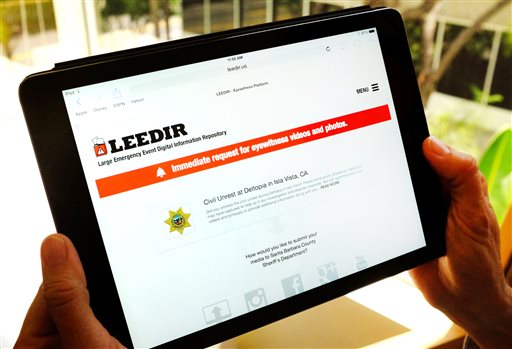Police use new tool to source crowds for evidence

This photo taken Thursday, April 24, 2014 in Los Angles, shows a tablet computer displaying a web site for LEEDIR or the Large Emergency Event Digital Information Repository that aims to make use of a document-everything culture evident on Instagram, Facebook and other social media to benefit law enforcement nationwide. AP PHOTO/RICHARD VOGEL
LOS ANGELES—An annual spring party in a Southern California beach town devolved into a riot last month when revelers turned violent, rocking cars, smashing windows and throwing rocks. Dozens were injured and about 50 people ended up in the hospital, including several police officers.
Today, as authorities seek help with the investigation in Isla Vista, they’re employing a new online and mobile app that designers say was created specifically for this type of situation.
“When the public really wants to catch these bad guys as badly as we do, this is the mechanism,” said Los Angeles Sheriff’s Cmdr. Scott Edson, who helped conceptualize the system in the aftermath of the Boston Marathon bombings. “They can help us by sending us pictures and video.”
The innovation, known as LEEDIR, the Large Emergency Event Digital Information Repository, pairs an app with cloud storage to help police use smartphones as tools to gather evidence.
Proponents say the crowdsourcing system gives authorities a secure, central repository for the countless electronic tips that can come in during a crisis. And since it uses remote database servers that police access online, floods of data won’t cause system crashes or be expensive to store. Most agencies, Edson said, “don’t have lots of bandwidth lying around.”
Privacy advocates criticize the app as overly broad, saying it subjects innocent people to police scrutiny and probably won’t produce much good evidence.
“There’s a reason that we pay professionals to work in police departments,” said Nate Cardozo, a civil liberties attorney with the Electronic Frontier Foundation. “And there’s a reason we don’t crowdsource photo lineups and the like — crowds aren’t good at it.”
Edson says he took note during the aftermath of the Boston attacks last year when authorities were inundated with videos and photos from people at the scene of the blasts. He figured a new tool could help streamline digital evidence-gathering. “It seemed like the perfect opportunity to go to the private sector,” he said.
Edson connected with Culver City, California-based tech startup CitizenGlobal Inc. and Amazon Web Services to design the system as a public-private partnership offered free to authorities and members of the public.
“With tens of millions of smartphones in use in the U.S., it’s a virtual certainty that citizens will be taking videos and photos at any terrorist attack, large-scale emergency or natural disaster,” CitizenGlobal co-CEO George D. Crowley Jr. said in a statement when the system was announced in November.
He said “real-time access to such content has, too often, been a matter of luck or chance” and this system will improve that process.
The Santa Barbara County Sheriff’s Office became the first agency to try out the technology after the Isla Vista violence, though results have been mixed. Spokeswoman Kelly Hoover said the system has been easy to navigate. But Hoover said they’ve received only a handful of submissions because it’s so new.
CitizenGlobal officials predict use will grow. The company designs crowdsourcing platforms for police, cities and schools, using Amazon Web Services as its backend, and LEEDIR helps showcase their work. Already, officials say, police agencies around the nation have shown interest in embracing technology.
Police departments in Philadelphia and Sacramento, California, encourage property owners to register security cameras for official use. Authorities in Houston and Los Angeles have sought access to traffic camera footage for investigations. And in suburban Atlanta, Marietta police use a tailored version of the crowdsourcing app to catch hit-and-run drivers and want to expand their system to include pothole reports, CitizenGlobal co-CEO Nick Namikas said.
“The paradigm for eyewitnesses has traditionally been ‘See something; Say something,'” Namikas said. “So now the paradigm is shifting to ‘See something; Send us something.'”
Tech innovations such as these could make it easier to report crime, said Dan Simon, a law professor at the University of Southern California.
“It’s an easier psychological process to upload video taken by cameras rather than filing complaints by going down to the police station,” he said.
Developers acknowledge the possibility that content could be misleading or doctored, but authorities say they would investigate any tips they receive. Submitted photos and videos would be used to corroborate other information gathered during the investigation, authorities say.
Still there are “massive privacy implications” in placing video or photos online that could implicate innocent people in criminal activity, said Cardozo, the civil liberties attorney.
The Boston Marathon attacks demonstrated the downside of crowdsourcing, he said. In the aftermath of the attack, social media users zeroed in on the wrong person, Cardozo said, calling the situation a “modern-day witch hunt.”
In requesting submissions from the public authorities will raise the profile of such content, he said, “and for the people on these videos, they might not expect or want their image to be forever associated with a terrorist attack or a bank robbery or a riot in Isla Vista.”—Tami Abdollah